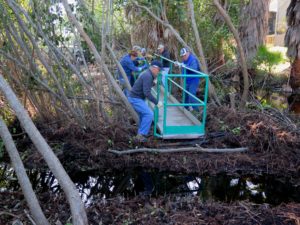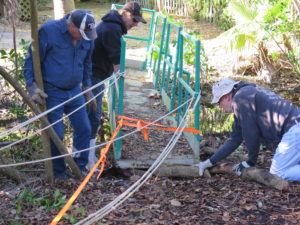
Serendipity — “the occurrence and development of events by chance in a happy or beneficial way,” – usually follows an unexpected path. The Shores of Long Bayou Homeowners Association (HOA) volunteers didn’t even know they needed a bridge when they started clearing invasive trees from their property. But we’re getting ahead of ourselves.
These volunteers are passionate about making their campus Brazilian pepper-free. It took three conservation grants – from the Tampa Bay Estuary Program, the Tampa Bay Environmental Restoration Fund and the Florida Exotic Pest Plant Council — with matching funding from the HOA, plus hundreds of volunteer hours, to remove the peppers on a two-acre plot.
They were so thick that we couldn’t easily estimate the job, sizing the work based only on the perimeter. Inside, it was a jungle. Neglected for over 20 years, the stream connecting Wood Stork pond with Long Bayou was inundated with invasives and muck, blocking any tidal flushing.
Tidal flushing is a primary concern because the TBEP estimates that nearly half of Tampa Bay’s coastal wetlands have been lost to development since the 1950s. Although the wetlands are actually stormwater ponds, they provide critical habitat to many commercially and recreationally important species.
“Once we began the removal, we were surprised to find that our neighbor had installed a heavy, 20-foot aluminum bridge across our bordering tidal stream, cleared an area in the dense growth, added soaker hoses, and had been growing marijuana (Cannabis) – only 100 yards from our HOA office,” said Merle Korejwo, HOA president. “Great, now what do we do?”

On advice from the city, the HOA wetlands committee sent a letter to the owner asking that he choose between removing the bridge at his expense or denying ownership, permitting the committee to remove the bridge.
“We naturally favored the latter approach. We wanted the bridge!” Korejwo said.
When the neighbor replied in our favor that afternoon, a dozen volunteers, muscles, grunting, pushing, a chain, some rolling logs, and a Ford F-250 later – we had the bridge on HOA land.
While positioning the bridge over the stream, we decided it needed a name. Although a number of options were suggested, the Mary-Jane Memorial Bridge seemed perfect. A few volunteers asked, “Who was Mary Jane?”
You just gotta love their innocence.
The ultimate goal of our project was to provide tidal flushing to the mangroves surrounding Wood Stork pond. Ditches dug decades ago to drain land or control mosquitoes had filled in and were choking the mangroves. Removing invasive trees and dredging the canal provided the life-giving brackish flushing needed to guarantee longevity. Like icing on a cake, we serendipitously received a bridge.
Originally published March 21, 2019
 By Ernie Franke, Chairman of Wetlands Committee, The Shores of Long Bayou Condominiums, eafranke@tampabay.rr.com. Franke has a master’s degree in electrical engineering, and worked for 37 years. His current interest is restoring stormwater ponds (eight currently in progress) and he serves as the chairman of the Wetlands Committee at The Shores of Long Bayou Condominiums. The efforts of the volunteers have been recognized by the Florida Native Plant Society (state awards for best landscape restoration in 2016 and residential multi-family in 2018), Keep Pinellas Beautiful (award for best Adopt-A-Shore project in 2016) and by the Tampa Bay Estuary Program (Golden Mangrove Award in 2012 and 2015 for the most outstanding project). Volunteers at The Shores also won a Florida Exotic Pest Plant Council (FLEPPC)/Cooperative Invasive Species Management Area grant and FLEPPC Kathy Craddock Burks Education grants in 2017 and 2018.
By Ernie Franke, Chairman of Wetlands Committee, The Shores of Long Bayou Condominiums, eafranke@tampabay.rr.com. Franke has a master’s degree in electrical engineering, and worked for 37 years. His current interest is restoring stormwater ponds (eight currently in progress) and he serves as the chairman of the Wetlands Committee at The Shores of Long Bayou Condominiums. The efforts of the volunteers have been recognized by the Florida Native Plant Society (state awards for best landscape restoration in 2016 and residential multi-family in 2018), Keep Pinellas Beautiful (award for best Adopt-A-Shore project in 2016) and by the Tampa Bay Estuary Program (Golden Mangrove Award in 2012 and 2015 for the most outstanding project). Volunteers at The Shores also won a Florida Exotic Pest Plant Council (FLEPPC)/Cooperative Invasive Species Management Area grant and FLEPPC Kathy Craddock Burks Education grants in 2017 and 2018.
Read more of Franke’s stories for Bay Soundings:
Simple Aquascaping of Your Retention Pond Using Native Plants
